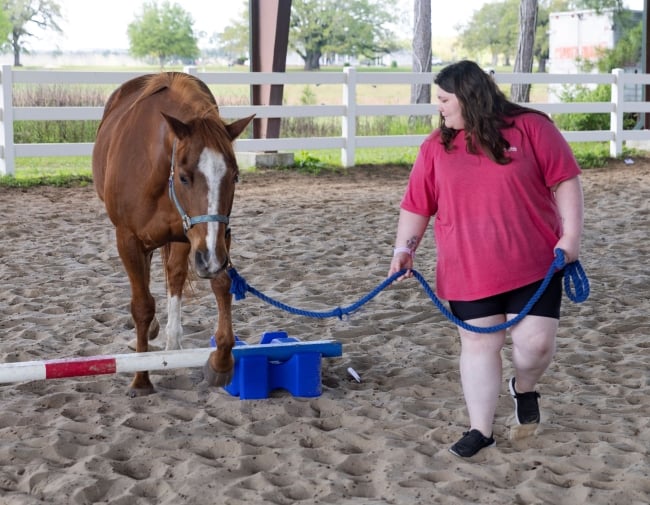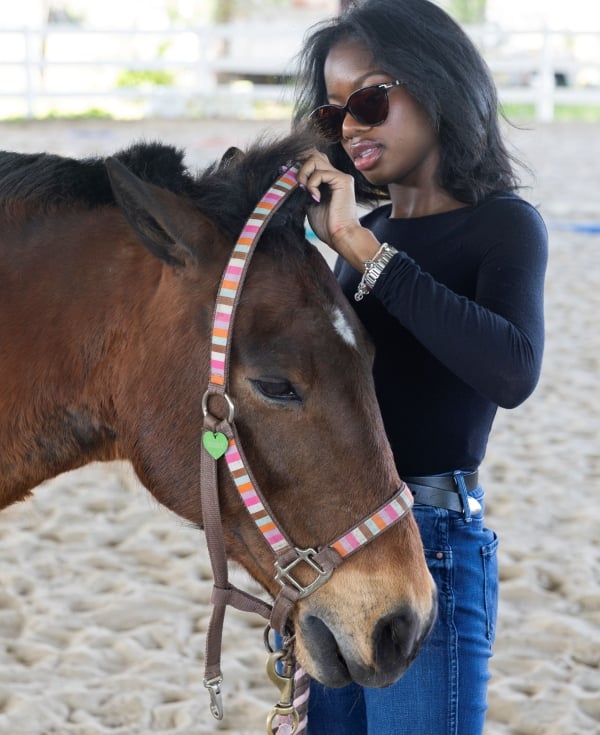You have /5 articles left.
Sign up for a free account or log in.

First-year students at Valdosta State University in Georgia can participate in a seminar that incorporates equine intervention into course content, teaching them how to work alongside horses and build confidence. VSU student Miranda Addison leads a horse through an obstacle course challenge during one barn day.
Valdosta State University
Incoming students at Valdosta State University in Georgia can saddle up into a first-year seminar course that makes horses the “mane” event. STRIDES, short for Students Together Reaching Individual Development and Educational Success, uses equine-assisted interventions to build students’ life skills and introduce students to working with horses.
The class serves a handful of first-year students each term and, through guided reflection and confidence-building exercises, leaves learners more curious and open, thanks to their 1,000-pound teachers, the horses.
The background: Two faculty members who describe themselves as “horse women” developed the class: Gwen Scott Ruttencutter, assistant professor in the department of leadership, technology and workforce development, and Kate Warner, associate dean of the college of education and human sciences.
Both instructors have a love for the animals and jumped at the opportunity to incorporate equines into a first-year seminar, first offered in 2022. In higher education, equine interventions are used with graduate level students, but less commonly with first-year students.
Horses are highly social and sensitive animals, and reflect a person’s behaviors back to them, Ruttencutter says. “People often describe them as mirrors; they help us see ourselves.” Equine-assisted learning can help students develop their authenticity, mindfulness, sincerity, assertiveness, effective communication, reliability and other life skills.
How it works: STRIDES fulfills a three-credit hour first-year seminar experience. The course takes place both at VSU and at Jacobs’ Ladder Therapeutic Riding Center, a local organization about a 20-minute drive from campus (students are provided transportation).
Both instructors, the facility and the owner are all certified to provide equine intervention, which is important because not all horses are capable of this kind of work, Ruttencutter explains.
While at the barn, students do not ride the horses but do other activities including grooming and haltering a horse and building an obstacle course and leading the horse through it.

During the final barn day of the semester, Chloe Mays, a first-year biology major, paints a horse with pictures of her academic journey so far. The exercise both served as a reflection for students at the end of the term but also showed their new relationship with equines.
Gwen Scott Ruttencutter
In the classroom, students complete readings and reflections on their equine activities, connecting them to their overall academic experience.
A central theme in the course is giving students skills to persist in their educational pursuits and in their lives beyond college. The course provides experiential and embodied learning that students can apply to their lives, reflecting on a tangible experience in which they were challenged or had to think creatively, Warner explains.
The impact: Overwhelmingly, student responses have been positive, the professors report.
“We’ve watched students blossom and feel much more comfortable in their own skin,” Warner says.
Most students had never been around horses before, and the experience is decentering, requiring them to navigate new feelings and challenges around a large animal that, as a prey animal, can be just as nervous as they are. By the end of the term, each student is confident in guiding a horse and caring for them, as well as more attuned to their own feelings.

Student Lauryn Morrow practices haltering a horse during a barn day.
Valdosta State University
The classroom assignments help students draw a comparison to their lives and identify their own fears and hesitancies in starting college or moving away from home.
In the future, Ruttencutter and Warner plan to continue offering the full-length course but are also considering ways to offer equine interventions as shorter term or one-off approaches. They also hope to target academically at-risk students, as well as incoming students, to build academic skills and promote thriving.
DIY: For faculty members curious about how to model the initiative, Ruttencutter and Warner offer three pieces of advice.
- Get off your high horse. The experience has helped students connect with their faculty members, who are right there along with them in the dirt working with the horses, which is important for this work. Faculty should lead with humility, commit to being vulnerable and be authentic in this space.
- Provide space for reflection. Because each day at the barn provides a new challenge for students, opportunities to reflect on what they are feeling and learning is critical. Students complete written and video reflections, which also provide helpful artifacts for faculty as they consider the course outcomes.
- Let the horses teach. “We designed a really good course, but the best teachers … were the horses,” Ruttencutter says, referring to the course’s four outcomes: growth mindset, self-direction and learning, team-building, and curiosity. Horses don’t lie and leaving space for authentic life learning through engagement with the animals benefited students more than any assignment.
If your student success program has a unique feature or twist, we’d like to know about it. Click here to submit.








